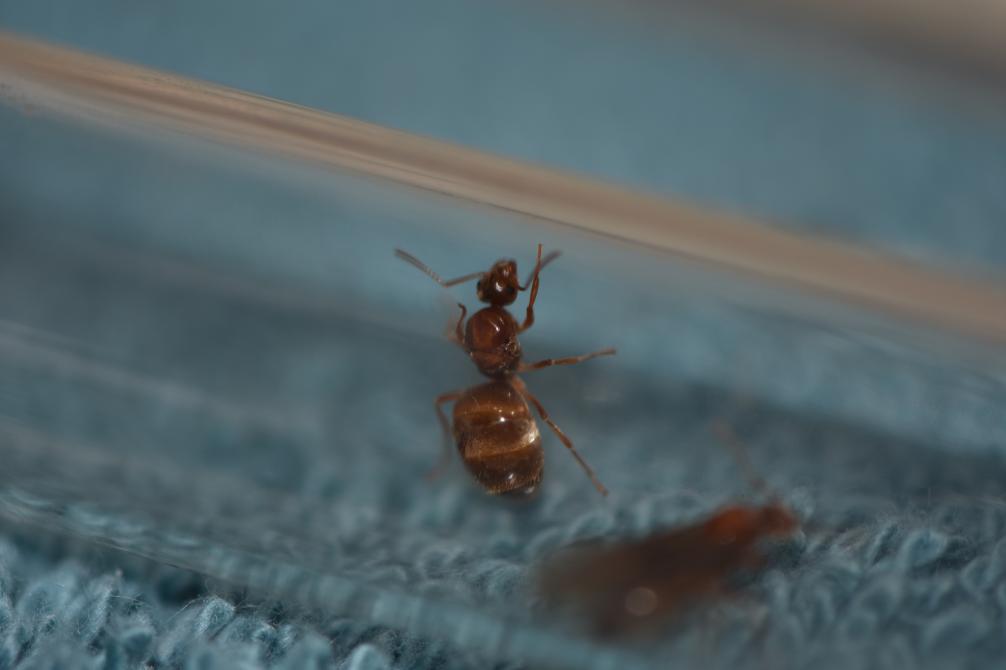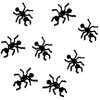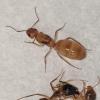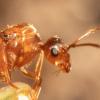Anthony's Prenolepis Guide and Info
This is a general guide of what I've seen as well as has been said by both legitimate sources and hobbyists on this very forum. At this time, parts of North America are experiencing Prenolepis impraris flights, famed for often being the first after winter. I created this as a way of documenting the species as a whole, as well as flights and captive conditions. This is not a care sheet.
Taxonomy
Prenolepis imparis was described by Thomas Say in 1835 under the name Formica imparis in Indiana (It has obviously been proven to be taxonomocally different). Since then, it has been described as many species such as Tapinoma nitens, soon reclassified as Prenolepis nitens americana. Samuel Buckley described Formica wichita in 1866, which is now a synonym of Prenolepis imparis.
There are many variants, or forms of this species, described by a few different myrmecologists. Carlo Emery distinguished Prenolepis imparis, Prenolepis imparis testacea, and Prenolepis imparis minutus. William Wheeler described an additional six, being pumila, californica, arizonica, coloradensis, veracruzensis, and colimana.
I will list the more notable variants here, which can usually be discerned without a microscope. Distribution by Wheeler in 1930, which means it may be outdated. Most observations by Wheeler.
var. testacea tends to nest in sand or sandy soil, often having nests near oaks. Workers are described as ranging from yellow to reddish yellow. The gaster and back of the head is often a darker color. Legs are yellow. Queens are described as being lighter, and more of a yellowish-red color than original imparis. This variant has a wide distribution in the United States, with it's list of states consisting of District of Columbia, North Carolina, Florida, Georgia, Mississippi, New York, New Jersey, Pennsylvania, Missouri, and Arizona. It is mostly southern and common in southern New Jersey.
var. pumila is pale like var. testacea, with the gaster being darker and the legs being yellow. Being in a few states, mostly eastern, this species is in North Carolina, Alabama, New York, and District of Columbia. The distribution is sporadic and it's likely there are more states to add.
var. californica is described as having darker workers than the original imparis in some cases but also having lighter workers occasionally. Workers are extraordinarily small, ranging from 2.3-2.5mm. Queens are 6-6.5mm, with wings longer than themselves. This variant is noticed in the southwest, in states like California and Nevada, and has also been found in Oregon. Wheeler called this form unstable and noted that it may need to be separated into multiple forms.
Distribution
Today, Prenolepis imparis is known to be distributed across almost all of the United States, and Ontario. I feel it may be appropriate to guess that the species could be in southern Quebec, based on reports near the border between Quebec and Vermont as well as similar conditions to where Prenolepis imparis can thrive. Prenolepis imparis also has sporadic reports in Mexico, which seems to be because of lack of material.
Biology and Ethology
The behaviors of this ant are apparent yet strange, as Wheeler believes this ant is "timid and retiring and perhaps to some extent crepuscular and even nocturnal". He noted they commonly avoid light and tend to nest in shadowy areas, and are common on cloudy or shady days. He compared the alates of this species to those of Lasius niger, which I can only assume refers to shape instead of color.
Prenolepis imparis workers will feed on honeydew from aphids, the nectar of flowers, and have even been noted to suck up the juices of earthworms. Earthworms are a primary source of food, especially as workers forage in colder temperatures and damp areas. Upon consuming liquids, the workers' gasters may become distended, which is observed to make their movement clumsy. Surprisingly, I observe this species roaming the invasive Japanese Knotweed (Reynoutria japonica) more than tending aphids on plants. I would assume they would forage on other plants more and frequent aphid infested stems more often in this plants absence.
The cold tolerance in this species is extraordinary and not seen in many others. The coldest conditions this species has ever been observed in was 6° Fahrenheit, on February 26th, 1928. They are said to be most active between 35° and 55° Fahrenheit. They're commonly observed living off of nothing but earthworms during cold periods.
Nuptial flights in this species almost always occur in the cool spring months, typically from March to May. Temperatures are typically above 66° Fahrenheit, and even then alates may fail to take off and return to the nest of their parent colony. I find flights more probable in conditions above 70°. Extremely sunny days may make queens stick to the forest. In April, 2018, I observed queens mate and drop their wings without taking off, sometimes being just inches apart from their parent colony. This behavior could be seen as a reaction to the high winds that day, as the forest which the parent colony was in had more cover from the wind, and it was less of a risk for the queens if they stayed near the nest. I did observe the workers attack the males as they attempted to mate. Males will gather under a chosen leaf that is near the nest when it is above 60. These groups are usually 1-3 dozen males with about a dozen or two workers with them. If this leaf is moved or lifted, the group scatters. If the temperature is not ideal, then after a while they'll typically go back into the nest. They'll also return to the nest if the temperature begins to drop or if there's lots of rain.
Captive and Catching Tips
I have heard and speculated over the fact that this species may be losing ground because of both climate change and deforestation in some areas, and although this may be false, I choose to stop myself, as a hobbyist, from collecting more than a few queens per year.
The flight conditions are stated above in Biology and Ethology. If you can't seem to find any queens for a while and it's already in the afternoon, I encourage you to go to a nearby forest and search near there. There will often be dozens of queens in areas where they're thriving, and they often stand out because of their bright colors. They sometimes climb trees and go beneath leaves in search of nesting locations.
Although polygynous, queens may still fight if there are too many of them. I suggest putting them separately, but some groups of two will likely fare well. Do not attempt to combine queens that already have colonies. I've seen people do this and think that it's worked, only to find that half of the workers and some queens have been culled sometime later. Brood boosting does not work in my experience with three of my colonies, which all refused to move the foreign brood. I suggest you keep them at a constant 70° or so. Colonies appear to be somewhat sensitive and some keepers struggle with giving them the right conditions for egg laying in the second year.
Egg to worker time is usually between two and three months, meaning queens typically get their first workers from late May-June depending on when they were caught. They seem to do well in a test tube until they absolutely cannot live in one anymore.
In captivity, I would typically try to keep them at 75-80° during the summertime. During this time, they'll likely eat less and be less active, but food should likely be offered to them anyway. In the winter, I keep mine out of hibernation until December, which is when I lower their temperature from 60s to around 30°. I warm them back up in late February.
Pictures
Beautiful pictures of P. imparis californicus by Irvosanjose.

Picture by Zmagz
Check these sources for even more extensive information on the species:
http://www.antwiki.o...eelerW1930h.pdf
http://www.antwiki.o...nolepis_imparis
Edited by AnthonyP163, April 7 2019 - 11:24 AM.





















